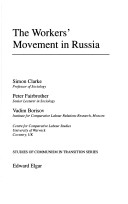Studies of Communism in Transition
1 total work
The Workers′ Movement in Russia
by Simon Clarke, etc., Peter Fairbrother, and Vadim Borisov
Published 1 January 1995
Perestroika's fate was determined by the hostile reaction of the working class. Strikes, protest and the fear of working class action had a devastating impact, yet relatively little is known about the workers' movement during this period. This book surveys the development of the new workers' movement in Russia under perestroika to understand how it connected with the workers at shop floor level and the national and local political authorities to whom it addressed its demands, and whose development it sought to influence. Drawing on a programme of collaborative research on Russian industrial relations from 1987 to 1992, the authors use a series of case studies to explain the gulf between the thousands of tiny independent groups, often based in a single enterprise or even a single shop and regional and national organizations without a grassroots base.
Extensive interviews with participants, tape and video recordings as well as substantial documentary material are used in case studies of the 1989 miners' strike in Kuzbass, the Kuzbass Regional Council of Workers' committees, the Independent Miner's Union in Kuzbass, Sotsprof in Moscow and the Federation of Air Traffic Controllers' Unions.
Extensive interviews with participants, tape and video recordings as well as substantial documentary material are used in case studies of the 1989 miners' strike in Kuzbass, the Kuzbass Regional Council of Workers' committees, the Independent Miner's Union in Kuzbass, Sotsprof in Moscow and the Federation of Air Traffic Controllers' Unions.
